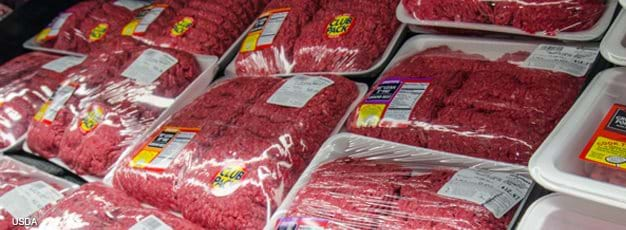Increased Consumer Sensitivity to Food Safety Raised Financial Costs of Ground Beef Recalls

Using data from a national panel of U.S. households for the period January 2002 through December 2005, researchers estimated a statistical model of household purchases of ground beef that examined both the decision to purchase ground beef and the quantity purchased. The model controlled for factors affecting purchases, such as the price of ground beef, household demographics, purchase habits, and the occurrence of region-specific recalls of ground beef by USDA’s Food Safety and Inspection Service (FSIS). The unique finding from this analysis is that the discovery of bovine spongiform encephalopathy (BSE) in a cow in the United States and the subsequent media coverage may have marked a turning point in U.S. consumers’ perceptions and subsequent responses to recalls of ground beef.
In late December 2003, USDA confirmed the first discovery of a BSE-positive cow in the United States. This announcement was followed by a marked increase in the amount of public information (e.g., media reports, public commentary) regarding food safety. From January 2004 to December 2005, FSIS issued 12 recalls of ground beef. In the 2-week period following each recall, household purchases of ground beef decreased by an average of 0.26 pounds per person in the areas where recalls occurred. In the pre-BSE period, FSIS recalls of ground beef were not followed by measurable changes in consumers’ probability of purchasing ground beef or the amount of ground beef purchased.
Prior to the BSE detection, the cost of a recall to the beef industry was the loss of the product FSIS identified as contaminated and the associated costs of removing the meat from commerce and destroying it. After the BSE detection, the biggest influence on the cost of recalls was the change in consumers’ purchases of ground beef. In the 2004-05 post-BSE period, the median amount of ground beef removed from commerce per recall was 98,000 pounds, with an estimated retail value of $223,220. In contrast, a 2-week decline in ground beef purchases of 0.26 pounds per person from a nationwide recall would have cost the beef industry over $97 million in 2005.
Comparing the pre- and post-BSE periods, the reduction in retail demand for beef associated with FSIS recalls greatly amplified their financial impact on the beef industry. If consumers react similarly to ground beef recalls today as they did in 2004-05, the reduction in beef demand following a recall would impose a much larger financial penalty on the beef industry than the value of the recalled products. However, the impact of the reduced demand on the incentive to make beef safe is still speculative. If reduced demand were targeted at the firms that pay the least attention to safety, it would increase their incentive to ensure product safety. But, if consumers treat all ground beef alike, the reduced sales penalty is imposed across the beef industry and is not targeted at firms responsible for recalls.
“Changes in U.S. Consumer Response to Food Safety Recalls in the Shadow of a BSE Scare,”, by Mykel Taylor, H. Allen Klaiber, and Fred Kuchler, Food Policy, 62, 56-64, September 2016

